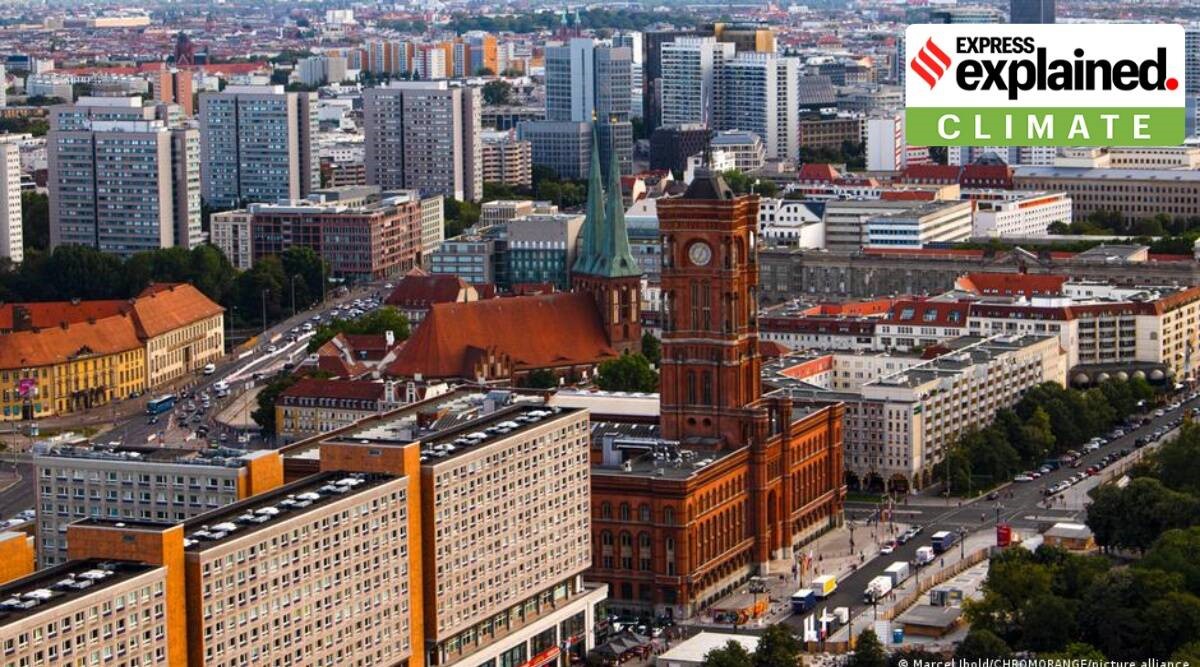Description

Disclaimer: Copyright infringement not intended.
Context: As liquified natural gas tankers carrying fracked US gas start to land in northern Germany, climate activists are calling it a major setback in the effort to limit global heating.
Details:
- LNG is to compensate for lost Russian gas supplies, with four new terminals set to come online in Germany alone.
- But though touted as a short-term fix, many fear the gas is here for the long haul as the EU becomes the biggest LNG importer in the world.
- With LNG creating almost 10 times more emissions than piped gas by one estimate, its rapid expansion will likely compromise climate targets, say, climate researchers, who also reject claims that most LNG infrastructure is suitable for green hydrogen in the future.
- And while LNG imports are key to the European Union’s REPowerEU energy plan, analysts say they will not offer relief from the current Russian gas shortfall until after 2024.
What is liquified natural gas?
- LNG is natural gas reduced to a liquid state (liquefaction) through intense cooling to around -161 degrees Celsius (-259 Fahrenheit).
- This liquid gas is 600 times smaller than the original volume and is half the weight of water.
- The compressed fossil fuel, which is constituted almost wholly of methane— a potent greenhouse gas —, can be transported around the world by ship.
- After arriving at its destination, the cargo is regasified in a floating terminal and redistributed through pipelines.
- The high cost of liquefaction and producing LNG has limited its market.
- The cooling, liquefying and transport processes, as well as the post-transport regasification procedures, also require a lot of energy.
Climate impact:
- A lot of energy is required to extract natural gas from a reservoir, to transport it from the gas field to the LNG facility for processing, to chill gas to such low temperatures, and to hold it at that temperature before it is warmed and regasified following a long sea or train journey.
- Methane loss across the supply chain risks also contributes to LNG’s high emissions.
- In the end, LNG emits about twice as much greenhouse gas as ordinary natural gas
- Processing LNG is so energy- and carbon-intensive that it can create almost 10 times more carbon emissions than piped gas.
.jpeg)
Supply of Liquefied Natural Gas in India:
- At present, the government has accorded the highest priority in domestic gas supply to City Gas Distribution (CGD) for distribution to the domestic household (cooking purpose-PNG domestic) and transport segment (CNG).
- The industrial and commercial users of the CGD network also consume market-determined price gas including LNG based on their respective techno-commercial considerations.
- At present, there is no cross-country LNG Pipelines in the country.
- Petroleum & Natural Gas Regulatory Board (PNGRB), under the PNGRB Act, 2006, has notified Technical and Safety Regulations for Natural Gas Pipelines in line with the various national/ international standards and the authorized pipeline entity are bound to comply the standards/specifications as provided under notified Regulations.
- The share of natural gas in the primary energy mix is envisaged to increase to 15% by 2030 by boosting domestic production and procuring LNG.
- LNG imports are under Open General Licensing (OGL) category and the establishment of LNG infrastructure, including LNG terminals, is also under 100% FDI (automatic route).
- Market of natural gas is being created by the expansion of gas infrastructure including City Gas Distribution, Gas Grid Network and the establishment of LNG retail outlets.
- Ministry of Road Transport and Highways has notified LNG as a transport fuel. LNG Terminals/Pipelines/City Gas Distribution Networks are being established to expand gas market.
LNG vs LPG vs CNG:
- LNG – Liquefied Natural Gas – is natural gas (methane) cryogenically liquefied.
- LPG – Liquefied Petroleum Gas – is mainly propane and butane alone or in mixtures liquified under pressure. LPG is produced from crude oil refining and natural gas processing.
- CNG – Compressed Natural Gas – is natural gas stored at high pressure.
- Natural gas (methane) is lighter than air and will typically disperse in the event of a leak. This is advantageous, over LPG, from a safety point of view.
- LPG is stored, shipped and distributed in cylinders or tanks. LNG is stored and shipped in special cryogenic tanks and then typically distributed via pipeline, after regasification.
- CNG is highly compressed natural gas in cylinders. LPG, propane and butane, are gas at 20°C and 1 atm (NTP) and liquefied under low pressure. Methane remains gas under pressure. LNG only liquefies cryogenically.
.jpeg)
https://indianexpress.com/article/explained/explained-climate/europe-turns-to-lng-instead-of-russia-gas-what-is-it-how-it-impacts-the-climate-8367101/














